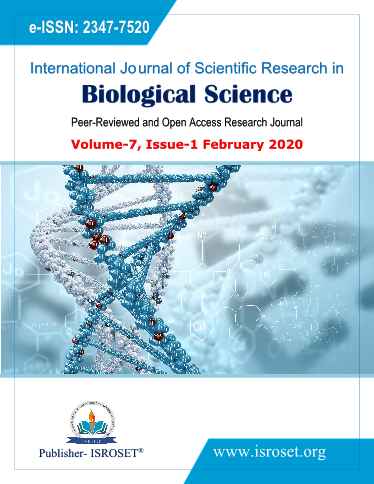Role of Sanger’s reagent on Vorticella stalk contraction performance
Keywords:
Sanger’s reagent, Vorticella stalk, contraction frequencyAbstract
Vorticella stalk contraction is a new type of machinery exhibited positive role for Sanger’s reagent in acidic medium. These range of acidic medium changes contraction frequency of the stalks up to the limited range of chemical reactions by the path and patterns of structural modification of stalks throughout the length of their extension. The ROS generated by the applied Sanger’s reagent in different concentration gradients slowed down the rate of contraction but unable to stop metabolic path and patterns of protein folding. Thus the experimental conclusion exhibited reversible physiological regulation of contraction in less acidic medium with extra-ordinary future applications in terms of advanced bio-molecular software utilisations.
References
Sokolovsky, M. Riordan, J. F. & Vallee, B. L., “Tetranitromethane. A reagent for the nitration of tyrosyl residues in proteins”, Biochemistry 5. 3582-3589, 1996.
Tatham, A. S. & Shewry, P. R., “Elastomeric proteins: biological roles, structures and mechanisms”, Trends Biochem. Sci., 25: 567-571, 2000.
Raj, M. Chatterji, A. Singh, A. K. & Amin, M., “Effect of extracellular pH and DNFB treatment on the mechanical performance of frog skeletal muscle”, Indian Journal of Biochemistry & Biophysics, Vol. 26, pp. 325-328, 1989.
Verma, A. K. & Singh, A. K., “Effect of DNFB treatment in combination with different pHs of the medium along the length of Vorticella stalk contraction dynamics”, International Journal of Current Research, Vol. 9, Issue. 07, pp. 54365 – 54368, 2017.
Shantosh, M. & Sarojnalini, Ch., “Nutritional Quality of Three Cobitid Fishes of Manipur, India: With Special Reference to Essential Mineral Elements”, International Journal of Scientific Research in Biological Sciences, Vol. 5, Issue. 2, pp. 24 – 33, 2018.
Singh, A. K. & Amin, M., “Oscillation in Nitella Cell membrane potential and its Effect on Cytoplasmic Streaming”, Current Science Vol. 58, No. 12, pp 669-672, 1989.
Singh, A. K. & Amin, M., “Effect of extracellular pH on membrane potential and cytoplasmic streaming in nitella and chara cells”, Indian Journal of Experimental Biology, Vol. 29, No. 3, 201-204, 1991.
Shiono, H. & Naitoh, Y., “Cellular contraction precedes membrane depolarization in Vorticella convallaria”, The Journal of Experimental Biology, 200, 2249-2261, 1997. Printed in Great Britain.
Riordan, J. F. Sokolovsky, M. & Vallee, B. L., “Tetranitromethane. A reagent for the nitration of tyrosyl residues in proteins”, J. Am. Chem. Soc. 88. 4104-4105, 1996.
Lijnzaad, P. Brendsen, H. J. & Argon, P., “Hydrophobic patches on the surface of protein structures”, Proteins: Structure, Function, and Bioinformatics, Vol. 25, No. 3, pp. 329-335, 1996.
Downloads
Published
How to Cite
Issue
Section
License

This work is licensed under a Creative Commons Attribution 4.0 International License.
Authors contributing to this journal agree to publish their articles under the Creative Commons Attribution 4.0 International License, allowing third parties to share their work (copy, distribute, transmit) and to adapt it, under the condition that the authors are given credit and that in the event of reuse or distribution, the terms of this license are made clear.







